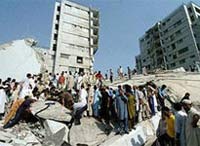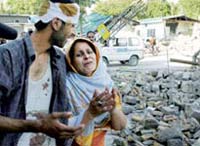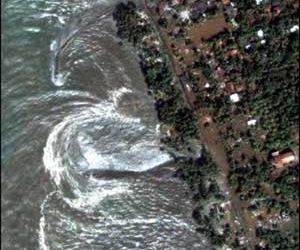Tens of thousands have died in the powerful 7.6 magnitude earthquake that struck the morning of October 8 in Pakistan, India, and Afghanistan. Authorities fear the final death toll will be “very high” due to the widespread impact of the earthquake.
Approximately 40,000 people in Pakistan have died, and around 41,000 have been injured in the earthquake in Kashmir.
Tariq Farooq, the official responsible for labor and communication in the Pakistani-controlled region of Kashmir, stated: “Our preliminary estimates suggest that over 30,000 people have died in Kashmir.”
He reported that many cities and towns have been completely destroyed.
In the F-10 area of the capital Islamabad, the 10-story Margalla Towers, each with 60 apartments (estimated to house 250 people), collapsed entirely when the earthquake struck. 24 hours after the towers fell, only one woman and one child were rescued, and 18 bodies were retrieved.
An emergency has been declared. All hospitals have been ordered to open their emergency rooms to victims of the earthquake. Pakistani President Pervez Musharraf and Prime Minister Shaukat Aziz surveyed the earthquake-affected areas and directed rescue operations. Aftershocks are expected to continue for several days, prompting residents to evacuate their homes.
President Musharraf established a relief fund, which he personally oversees, and called on both domestic and overseas Pakistanis to contribute to the earthquake victims. At Prime Minister Shaukat Aziz’s residence, an office for coordinating relief and addressing the aftermath of the earthquake has been set up, complete with a hotline for public information. On October 9, the Pakistani government declared a three-day national mourning period to honor the victims of the earthquake.
According to local security officials, among the casualties are more than 200 Pakistani soldiers in Kashmir and 400 students from two schools in the region. Due to fears of aftershocks, hospital doctors in the area have had to treat patients outdoors to avoid the risk of building collapses.
Military and professional rescue forces have been dispatched to the mountainous regions. Helicopters have been mobilized to transport medical supplies. The authorities have officially ordered an increase in transport aircraft and helicopters to meet emergency rescue needs.
Islamabad continues to clear the rubble from the collapsed high-rise buildings. According to local media reports, rescue teams also managed to save some individuals from the debris last night.
Last night, Islamabad experienced more mild aftershocks, with scientists recording 45 aftershocks, the strongest reaching a magnitude of 6.0. Experts predict that the region may experience more significant tremors in the coming days.
There are numerous reports of casualties in cities and villages in northern Pakistan, India, and southern Afghanistan.
Regarding the cause of this earthquake, Chinese experts believe that the increased movement of the Indian tectonic plate colliding with the Eurasian plate is the “culprit” behind this significant earthquake.
Zhang Xiaodong, Deputy Director of the China Seismological Network Center, stated that there are two collision zones, referred to as “connection points,” between the Indian and Eurasian plates—one in the Pamir region at the northwest corner of the Indian plate and another in the Axamu region at the northeast corner, near the border of Myanmar and the provinces of Yunnan and Tibet (China).
The earthquake on October 8 occurred at the “connection point” in the northwest corner of the Indian plate. If we relate this to the two major earthquakes that struck on December 26, 2004, and March 29, 2005, in the Sumatra region (Indonesia), which is at the eastern boundary of the Indian plate, it can be concluded that the Indian plate is colliding more forcefully with the Eurasian plate.
 |
| The devastating scene in Islamabad after the earthquake. |
In a message to President Musharraf, Indian Prime Minister Manmohan Singh offered assistance for rescue and relief efforts. In the Indian-controlled part of Kashmir, at least 583 people have died, including some soldiers, and at least 800 have been injured; over 2,700 homes have been completely destroyed or severely damaged. On the same day, the Indian cabinet held an emergency meeting to assess the earthquake situation and discuss recovery measures. The government decided to allocate 1 billion rupees (approximately 22 million USD) to assist the Kashmir administration in dealing with the aftermath of the earthquake.
The world helps South Asia recover from the earthquake
A 9-member delegation from the United Nations Disaster Assessment and Coordination (UNDAC) arrived in Pakistan on October 9 to assist with the earthquake recovery. On the same day, the UK dispatched a second rescue team to Pakistan, while neighboring Afghanistan announced it would send aircraft, medical personnel, and 3 tons of medicine to Pakistan.
UN Secretary-General Kofi Annan and many world leaders sent condolences to the government and people of Pakistan and offered to send relief supplies and rescue teams to the country. The World Bank (WB) has decided to provide 20 million USD in aid to Pakistan, while the Asian Development Bank (ADB) is also providing 10 million USD in emergency aid to the hardest-hit areas in the country. The European Commission (EC) announced it would support 3.6 million euros (4.3 million USD).
UNICEF has also begun delivering aid supplies to the country. The UK announced emergency aid of 100,000 pounds (176,000 USD), the US provided 100,000 USD, and Australia sent medical supplies and rescue equipment worth 380,000 USD.
The French government stated it is also sending a 25-member emergency rescue team, while Foreign Minister Philippe Douste-Blazy pledged to provide “any assistance that Pakistan may need.” The Irish government also pledged an initial support of 1 million euros. In Berlin, German Foreign Minister Joschka Fischer announced that the country had immediately provided 50,000 euros to Pakistan, and German Chancellor Gerhard Schroeder sent a letter of condolence to the leaders of Pakistan and India.
Japan has sent 50 emergency rescue teams to Pakistan.
Russia sent an aircraft carrying 30 rescue personnel along with search dogs and supplies to Islamabad, which is expected to land in the Pakistani capital at 2 PM on October 9.
US President George W. Bush announced that aid is on the way to the victims. In a statement released by the White House on the evening of October 8, President Bush said: “The American people extend their deepest sympathies for the loss and devastation caused by the earthquake outside Islamabad. We are deploying relief and are ready to provide further assistance if needed.”
Chinese leaders, including President Hu Jintao and Premier Wen Jiabao, also expressed their condolences and deep sorrow for those who lost their lives in the earthquake to President Musharraf. Iranian President Mahmud Ahmadinejad declared that his country is ready to provide any assistance necessary to Pakistan, stating, “Our country is prepared to do everything for Pakistan… and share in the pain of our Pakistani brothers.”
Landslides in Guatemala: 1,400 dead
 |
| The people of Pakistan mourn the loss of loved ones in the Kashmir earthquake. |
On October 9, rescue workers in Guatemala reported that approximately 1,400 people have died under the devastating landslides in the village of Panabaj, Guatemala. In some areas, the landslide was as thick as 12 meters.
This was the result of a week of heavy rainfall caused by the storm named Stan.
The landslides began on October 5, but it wasn’t until October 8 that the first reports of the disaster emerged. Rescue efforts only started two days after the landslides occurred.
Hector Sicaia, the rescue coordinator, stated: “The landslides buried many houses. In many areas, the landslide is 5 meters thick. We are working from the rooftops of the houses.”
Currently, local villagers and rescue workers, exhausted, are still digging to find more people who may be trapped, but they are considering giving up the search and declaring the area a mass grave.
In 1998, a storm caused approximately 10,000 deaths in Central America, primarily due to landslides.
| Some major earthquakes in Asia from 2001 to present.
– 2001: A 7.9 magnitude earthquake devastated much of Gujarat, Northwestern India, resulting in about 30,000 deaths and over 1 million people displaced. – 2002: Approximately 150 people died in an earthquake in Afghanistan with a magnitude of about 7.2 centered in Samangan province. – 2003: A severe earthquake with a magnitude of 6.6 struck Bam, Kerman province in southeastern Iran, resulting in approximately 50,000 deaths and injuries. – 2004: An 8.9 magnitude earthquake triggered a tsunami off the coast of the Indian Ocean, causing hundreds of thousands of deaths and tens of billions of USD in damages. – 2005: An 8.7 magnitude earthquake shook the coast of Sumatra, Indonesia, resulting in approximately 2,000 deaths. |



















































